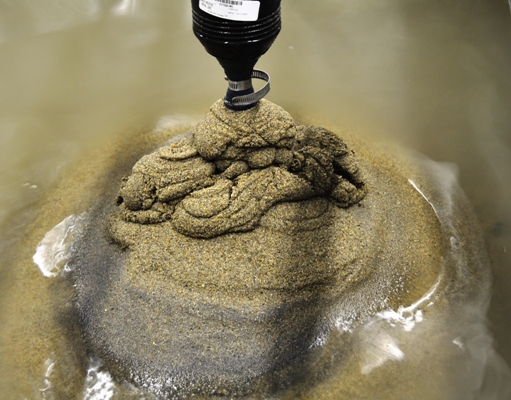Physical Properties of Oil & Gas Particulate Solids - Volume Fraction (B-FSM-0014)

Conversion between particulate sand actual volume, effective volume, and weight (in a dispersed slurry) requires both apparent density of the sand and the volume fraction solids. Also called packing density, the volume fraction is the portion of the total volume taken up by the solids.
Settled solids, in a tank, separator, or accumulator do not take up 100% of the contained volume. The pore space between the particles contains liquid or gas, so density conversions must consider this “other” volume. The reciprocal of volume fraction is void fraction or effective porosity.
Packing density can be reported as fractional value (0-1) or percent value (0-100). A value of 1, or 100, means there is no void space and all volume is filled by solids. Analysis of produced sand samples in our lab, received from oil and gas fields around the world, shows that this material has a volume fraction ranging from 0.52-0.67. The average value is 0.62, which is the default we use in our calculations when a sample is not present. This value is dependent on particle size distribution and particle shape.
Analysis for volume fraction can be completed in the field or in the lab with a simple measurement.
- Use a glass or plastic graduated cylinder (100 ml is good size).
- Add dry material to level volume. Can be 100 ml if the solids are inert or will shrink, or can be 75 ml if the solids will expand.
- Add/measure water until level with solids. Allow time for solids to react with water – either shrink or expand. Also ensure no air bubbles are trapped in void space.
- Capture final solids level.
- Volume of water added is direct amount of void fraction.
- The photo below shows this setup – using a plastic 100 ml graduated cylinder and a burette for water addition.

Calculations
Example 1:
A well produces 100 kg/d of sand, which is separated by a wellhead desander with a 183-liter accumulator. How fast will the accumulator fill up?
- Assumptions: Sand apparent density is 2650 kg/m³ (average for silica-quartz) and volume fraction solids is 0.62 (average stated previously).
- 100 kg/d of sand converts to 0.0377 m³/d = 37.7 liters. This is the actual sand volume.
- The sand does not pack at 100% density; thus, the effective volume is 37.7/0.62 = 60.9 liters.
- The accumulator will fill up in 3.0 days.
Example 2:
A free-water knockout separator at 3-meter diameter and 10-meter length (cylindrical section – inlet to weir) has settled solids at 0.5-meter depth. What is the weight of these solids?
- Assumptions: Ignoring dished end of separator and using cylindrical section only. Solids apparent density are 2780 kg/m³ and volume fraction is 0.58 (using different values just for calculation purposes).
- Effective volume of solids in separator (using horizontal cylindrical segment formula from Wolfram) = 7.744 m³.
- Actual volume of solids = (7.744)(0.58) = 4.492 m³.
- Weight of solids = (4.492)(2780) = 12486 kg
The packing density is a simple number that has profound effect on calculations involving particulate solids. Be sure to measure this factor when analyzing solids in your production facility.
